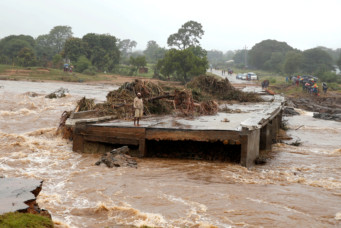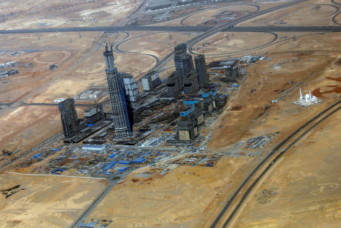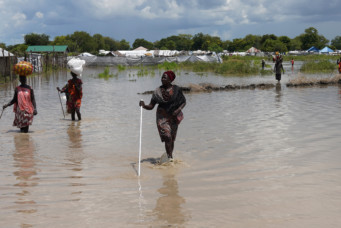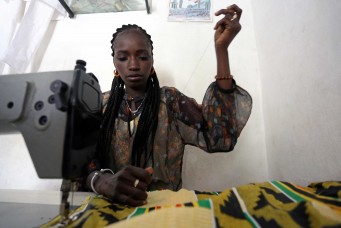Hearing the Global South in Climate Convos
If progress on climate change is to be made, voices from the most vulnerable Global South and African countries must be heard and included in conversations at climate conferences

Climate activists take part in a protest during the COP27 climate summit in Sharm El-Sheikh, Egypt, Nov. 19, 2022. Mohamed Abd El Ghany/Reuters
On November 6, 2022, all eyes focused on the twenty-seventh cycle of the United Nations Climate Change Conference—more commonly known as COP27—which was held in Sharm El-Sheikh, Egypt. It was used as a platform for which nations of the Global South could practice climate diplomacy. The centering of the Global South in the climate conversation will continue at least until next year when COP28 will be held in Dubai.
The location for these yearly gatherings is significant on multiple fronts. By holding COP27 in a North African nation, representatives of countries from the Global South were not only able to highlight the climate plague impacting Africa, but also bring to the world’s attention how the wealthiest countries, which often contribute the most to worsening climate conditions, tend to be spared the worst consequences of these events. The poorest, most vulnerable countries in the Global South, on the other hand, remain the most impacted.
Africa: The Least Emitter, The Most Impacted
Recent reports by the United Nations show that by 2030, acute water shortage is expected to impact around 250 million people on the continent and displace up to 700 million. Four out of five African countries do not have the capabilities to manage water resources sustainably, making the continent one of the most vulnerable spots on the planet.
Water shortage and severe droughts are not the only climate-related stresses impacting Africa. Temperature increases have made 2021 the third or fourth warmest year on record, and since 1961, the continent has experienced a reduction of about 34 percent in its agricultural activity, more than any other region on the planet. Sea level rise along African coastlines and wildfires have made climate-related hazards one of the primary contributors to food shortage, conflict, displacement, and political instability. In fact, according to the UN Environment Programme, an increase in temperatures equivalent to 2 degrees Celsius would reduce agricultural yields in sub-Saharan Africa by 10 percent by the 2050s.
An increase by 3 degrees Celsius would create conditions unsuitable for growing maize, millet, and sorghum—some of the most important crops on the continent. If these scenarios come true, it would be extremely troubling, especially since Africa contributes only around 3.8 percent of the world’s carbon dioxide emissions—the smallest share in the world—compared to other developed nations like the United States, which contributes around 26.4 percent. In other words, while the continent that is home to 15 percent of the Earth’s population contributes the least to global emissions, it is one of the worst impacted regions as a result of changes in climate patterns.
Beyond Africa: Climate Vulnerability in the MENA Region
The Middle East and North Africa (MENA) region, too, is one of the most vulnerable regions to climate change, and no country will be spared. This includes the affluent Gulf countries that will experience a lack of access to fresh water supplies in the next three decades. The region is home to twelve out of the seventeen most water-stressed countries in the world. According to estimates by the World Bank, climate change is expected to impact the region’s economic stability or, more specifically, devastate about 6 to 14 percent of its GDP by 2050.
Beyond the decline in water resources due to severe droughts and mismanagement of resources, the region is experiencing an increase in temperatures that—if left uncontrolled, according to some estimates—can make parts of the region uninhabitable for humans. Temperatures are also rising twice as fast as the global average and are expected to increase by 5 degrees Celsius in MENA by the end of the century if no action is taken. This is particularly an issue because when compared to the global average, the region could experience an additional increase of 1.4 to 1.8 degrees Celsius for every degree of global warming. However, while Africa is one of the least contributors to global emissions, the MENA region lags behind other regions in terms of controlling emission goals, having transparency with Carbon Disclosure Project (CDP) compliance—an international non-profit organization that helps companies and cities disclose their environmental impact—and meeting the Science Based Targets initiative (SBTi) approved targets. The CDP helps mobilize the private sector to take urgent climate action.
However, not all MENA countries are equal contributors to global emissions. For example, Iran, Oman, Iraq, and Saudi Arabia have failed to effectively decouple their economic growth from being strongly associated with the consumption of fossil fuels. On the other hand, Tunisia, Lebanon, and Djibouti have achieved relative decoupling, and Bahrain and Jordan have achieved absolute decoupling. As a result, economic dependency on oil and gas production in some countries in the region has significantly contributed to worsening regional climate conditions. For example, CO2 and CH4 accounted for 91 to 96 percent of gas emissions in the past five decades, with Iran, Iraq, and Saudi Arabia being the three largest emitters of the greenhouse gas CH4, and Iran, Saudi Arabia, Turkey, Egypt, and Iraq the biggest producers of CO2 in the region.All of these have contributed to increases in temperatures over time and to the growing frequency, duration, and intensity of extreme weather.
Climate Crises Traversing Borders
Beyond the immediate impact of extreme weather patterns, like floods and wildfires, climate change can be considered a threat multiplier or an event that can exacerbate and expose already existing weaknesses and limitations. As a result, countries—many of which in the Global South—with limited state capacity, weak institutional structures, undiversified economies, outdated infrastructure, and that are conflict-prone are more likely to experience aggravated climate impact than countries with better resources.
Yemen is a good case in point when looking at climate-related displacement. More than 4.7 million Yemenis have been internally displaced since the outbreak of the war in 2014. Combined with a collapsing infrastructure, the conflict led to unprecedented famine, which left around 23.4 million people in need of humanitarian assistance, 17 million people food insecure, and 3.5 million children and breastfeeding or pregnant women suffering from acute malnutrition. Climate-related events have magnified the situation. One such example was the coastal flooding affecting northern and central Yemen in 2022, which came after a severe drought in the first half of the season, impacting more than 300 thousand individuals (many of them were already displaced). These events forced families to migrate either externally, if they could afford it, or internally to other parts of the country that were also experiencing a crisis. This climate migration trend generally increases the odds of further conflict over diminishing resources.
Overall, the continuous deterioration of climate conditions in the MENA region and in Africa is creating circumstances for mass internal and external displacement that will imminently be knocking on the doors of Europe. Furthermore, climate-related events are likely to have a substantially negative impact in poorer, hotter, and lower-lying countries, which, combined with migration from rural to overpopulated centers, will increase conflict over increasingly scarce resources and job opportunities.
This fuels political instability and conflict which will increase displacement and ultimately affect energy markets, especially since countries in the region are some of the world’s main oil and gas exporters. These events will majorly impact political, economic, and social stability in Europe and the United States.
Global South in the Climate Conversations and Solutions
While richer countries have long evaded the consequences of their economic and political policies, they cannot continue to escape the effects of the conditions they have created. It is also no longer possible for the West to marginalize the Global South decision-making processes of climate response or evade its responsibility toward the poorest and most vulnerable of these countries. Certainly, the wealthiest nations have been lagging behind on these fronts.
For example, Global North countries still do not provide enough to support and strengthen Africa’s climate change response. Africa’s role in fighting climate change and its potential for renewable energy is massive and untapped; progress in that direction requires both industrialization and decarbonization and massive investment. Most importantly, Africa should receive a commitment from the main contributors to the climate disaster, mainly developed countries in the Global North, to fulfill their promises, cut their emissions, and invest in renewables in countries and locations that are most impacted by climate change.
These steps can slow down the negative impact of worsening climate changes in the region and globally. Yet, many top carbon-emitting countries are far from taking these steps. For example, despite estimates that the United States contributed approximately 1.9 trillion dollars in climate damage to affected countries between 1990 and 2014, U.S. president Joe Biden in 2021 pledged a meager $5.7 billion per year for developing countries by 2024 while also pushing for more oil and gas production at home to bring down energy prices that spiked due to the Russian invasion of Ukraine. Even with the healthcare and climate change bill, or the Inflation Reduction Act, under Biden’s belt, the United States remains behind in its efforts to support the Global South, with Biden announcing at COP27 a modest 150 million dollars as a “down payment” to tackle climate change, despite the immensity of the obstacles ahead. But are there better alternatives for climate action?
Some activists have called for the Global North to accept a “loss and damage (L&D)” approach rather than implementing the usual neoliberal economic policies, which they say do more damage to local communities and to the climate itself. Alternatively, they suggest taking the humanitarian aid approach, which in itself is a form of rent that creates dependency and rarely helps countries build resilient institutions that are needed to engage in more effective climate response. Discussion of the loss and damage approach was first initiated and adopted with the 2007 Bali Action Plan and later in the Cancun Adaptation Framework, which called for the establishment of compensation mechanisms for developed and rich countries to financially support efforts for mitigation and adaptation climate policy in developing and poorer nations. While later conventions such as the Warsaw International Mechanism and the Paris Agreement have created language to “advance knowledge gathering, coordination and support to address L&D,” there is no indication that developed countries will consider financial support of that nature. Despite that, progress toward prioritizing climate-related policy, where the Global South is the center of the conversation, is being made.
However, that progress is slow and not adequate for the level of crisis at hand. Future efforts need to incorporate the interest of local communities and activists through knowledge-sharing, but also through directly targeting state capacity and building institutional quality in the most impacted nations. Without these steps, the climate crisis will have a wider-reaching and inescapable impact within the Global South, and the cold (or hot) claws of climate will reach the Western countries sooner rather than later.
How to Achieve Progress
Meanwhile, while progress is slow on some of the more radical and meaningful steps that the wealthiest nations can take, there are important steps that can be taken to pave the way further toward impactful solutions. These steps, which include holding high-profile climate events and gatherings in the Global South and making the region the focus of the conversation, can significantly mitigate the global impact of climate change.
First, no effective climate action can be taken on a global scale without including affected countries as part of the conversation. Second, including countries of the Global South as equal partners is necessary because these countries, in the form of their governments, activists, and local communities, have a clearer understanding of their own needs and their own contributions to the climate crisis, which ensures a more impactful response. For example, some of the key moments of COP27 were the visit from then Brazilian President-elect Luiz Inácio Lula da Silva as well as the resumption of climate discussions between China and the United States, which highlighted key cooperation between major actors that can hopefully go further into COP28. Third, it is important to not view all countries of the Global South as victims in the climate change game.
While African countries are some of the most impacted yet least responsible for greenhouse gas emissions, some MENA countries, especially those with rentier economies, do play an important role in the climate crisis. As a result, solutions and analysis must take into account the unique social, economic, and political makeup of different countries in the region, as each has its own distinct conditions. This could be a potential challenge in the upcoming COP.
Combining accountability from the wealthiest nations with the knowledge and tools from local communities, while also creating spaces and resources that focus on building resilient institutions, is not only important, but is also necessary for global social, economic, and political stability.
Zeinab Shuker is Assistant Professor of Sociology at Sam Houston State University in Texas and a visiting climate fellow at Century International and the Emirates Policy Center. Her upcoming book with Rowman & Littlefield publishing group is titled Structural Limitations and Climate Change Vulnerability in the MENA Region: Iraq and The Case of the Hybrid-Rentier State.
Read More




